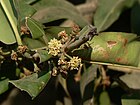Note: This is a project under development. The articles on this wiki are just being initiated and broadly incomplete. You can Help creating new pages.
Difference between revisions of "Manilkara hexandra - Kshirini"
(→External Links) |
(→External Links) |
||
| Line 93: | Line 93: | ||
[[Category:Tree]] | [[Category:Tree]] | ||
[[Category:Ayurvedic herbs that don't have seed photos]] | [[Category:Ayurvedic herbs that don't have seed photos]] | ||
| + | [[Category:Sapotaceae]] | ||
Revision as of 16:02, 24 May 2019
Kshirini is a small tree with glossy leaves and very fragrant flowers closely realted to the Sapota (Manilkara zapota) The stems and leaves exude a milky sap when bruised.
Contents
- 1 Uses
- 2 Parts Used
- 3 Chemical Composition
- 4 Common names
- 5 Properties
- 6 Habit
- 7 Identification
- 8 List of Ayurvedic medicine in which the herb is used
- 9 Where to get the saplings
- 10 Mode of Propagation
- 11 How to plant/cultivate
- 12 Commonly seen growing in areas
- 13 Photo Gallery
- 14 References
- 15 External Links
Uses
Parts Used
Chemical Composition
Common names
| Language | Common name |
|---|---|
| Kannada | bakula, hale hannu, khiranee, kiraale, ksheera vriksha |
| Hindi | khir, khirni, kshiri, ranjan |
| Malayalam | khrini, manilakkara, palamunnippalaelengi, pala |
| Tamil | kannupalalai, kanupala, karupala, kirni, palai, ulakkaipalai |
| Telugu | kirni, manchipala, manjipaala, Pala chettu |
| Marathi | NA |
| Gujarathi | NA |
| Punjabi | NA |
| Kashmiri | NA |
| Sanskrit | rajadana, drdhaskandha, kshirashukla, kshiravriksha, kshiri, kshirika, kshirini, ksiri, madhuphala |
| English |
Properties
Reference: Dravya - Substance, Rasa - Taste, Guna - Qualities, Veerya - Potency, Vipaka - Post-digesion effect, Karma - Pharmacological activity, Prabhava - Therepeutics.
Dravya
Rasa
Guna
Veerya
Vipaka
Karma
Prabhava
Habit
Identification
Leaf
| Kind | Shape | Feature |
|---|---|---|
| Simple | alternate | estipulate; petiole 8-20 mm, slender, slightly grooved above, glabrous; lamina 5-10 x 3-4.5 cm, elliptic, elliptic-obovate, obovate or ovate-oblong; base acute; apex obtuse or emarginate; margin entire, glabrous, coriaceous; lateral nerves 10-20 pairs, closely pinnate, slender, midrib raised below; intercostae reticulate. |
Flower
| Type | Size | Color and composition | Stamen | More information |
|---|---|---|---|---|
| Bisexual | axillary | Pale yellow | 10 | 7 mm across, white, 1 or 2 axillary; pedicel to 3.5 cm long; calyx lobes 6, in 2 series of 3 each, 2.5 x 2 mm, reflexed, ovate, subacute, rusty-tomentose outside; corolla 3 x 1.5 mm, lobes 18 in 3 series of 6 each, valvate; stamen 6-8, alternating with staminodes, bifid; staminodes shorter than stamen, filaments glabrous, lanceolate; ovary pubescent, 12-celled, superior; style 4-5 mm, subulate; stigma simple. |
Fruit
| Type | Size | Mass | Appearance | Seeds | More information |
|---|---|---|---|---|---|
| A berry | 1.5 x 8 mm | Ellipsoid, reddish-yellow | seed usually one. | {{{6}}} |
Other features
List of Ayurvedic medicine in which the herb is used
Where to get the saplings
Mode of Propagation
How to plant/cultivate
Season to grow
Soil type
Propagation
Commonly seen growing in areas
Photo Gallery
References
External Links
Categories:
- Herbs with common name in Kannada
- Herbs with common name in Hindi
- Herbs with common name in Malayalam
- Herbs with common name in Tamil
- Herbs with common name in Telugu
- Herbs with common name in Sanskrit
- Habit - Tree
- Herbs that are commonly seen in the region of Tropical area
- Herbs
- Tree
- Ayurvedic herbs that don't have seed photos
- Sapotaceae





